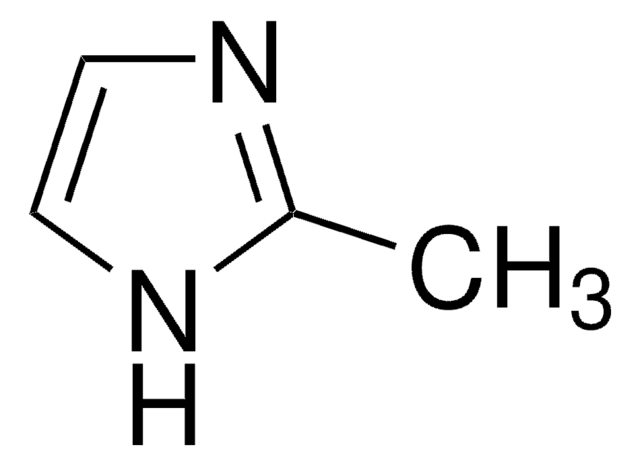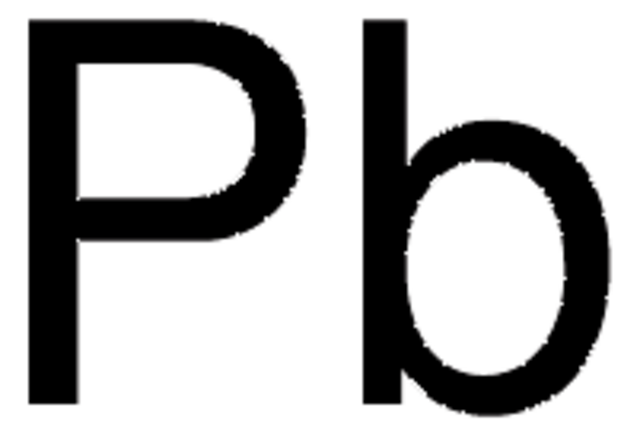243434
Tin
granular, 0.425-2.0 mm particle size, ≥99.5%, ACS reagent
Synonyme(s) :
Sn
Se connecterpour consulter vos tarifs contractuels et ceux de votre entreprise/organisme
About This Item
Formule empirique (notation de Hill):
Sn
Numéro CAS:
Poids moléculaire :
118.71
Numéro CE :
Numéro MDL:
Code UNSPSC :
12161600
ID de substance PubChem :
Nomenclature NACRES :
NA.22
Produits recommandés
Qualité
ACS reagent
Niveau de qualité
Pureté
≥99.5%
Forme
granular
Pertinence de la réaction
core: tin
reagent type: catalyst
Résistivité
11 μΩ-cm, 20°C
Taille des particules
0.425-2.0 mm
Point d'ébullition
2270 °C (lit.)
Pf
231.9 °C (lit.)
Densité
7.310 g/mL at 25 °C (lit.)
Traces de cations
As: ≤1 ppm
Cu: ≤0.005%
Fe: ≤0.01%
Pb: ≤0.005%
Sb: ≤0.02%
Chaîne SMILES
[Sn]
InChI
1S/Sn
Clé InChI
ATJFFYVFTNAWJD-UHFFFAOYSA-N
Description générale
Tin (Sn) is a silvery-white metal that is malleable and ductile at ordinary temperatures. It is used as a catalyst in organic synthesis. It is also used in various sectors, such as nuclear energy, plastics, polymers, agriculture, biochemistry, and in glassmaking.
Application
Applied in the solid state synthesis of a Zintl phase, SrSn3Sb4, with an anionic channel framework of 30-membered rings.
Tin can be used in the following:
- With HCl, it reduces a variety of functional groups.
- Stereoselective allylation of carbonyl compounds.
- In situ generations of tin enolates for directed aldol reactions.
- Preparation of organotin reagents.
Code de la classe de stockage
13 - Non Combustible Solids
Classe de danger pour l'eau (WGK)
WGK 3
Point d'éclair (°F)
Not applicable
Point d'éclair (°C)
Not applicable
Équipement de protection individuelle
Eyeshields, Gloves, type N95 (US)
Faites votre choix parmi les versions les plus récentes :
Déjà en possession de ce produit ?
Retrouvez la documentation relative aux produits que vous avez récemment achetés dans la Bibliothèque de documents.
Les clients ont également consulté
Donna T. Chow et al.
Inorganic chemistry, 36(17), 3750-3753 (1997-08-13)
The new Zintl compound strontium tin antimonide, SrSn(3)Sb(4), has been synthesized, and its structure has been determined by single-crystal X-ray diffraction methods. It crystallizes in the orthorhombic space group -Pnma with a = 10.060(2) Å, b = 4.361(1) Å, c
P Olmedo et al.
Environment international, 59, 63-72 (2013-06-25)
Although fish intake has potential health benefits, the presence of metal contamination in seafood has raised public health concerns. In this study, levels of mercury, cadmium, lead, tin and arsenic have been determined in fresh, canned and frozen fish and
Lun Li et al.
Journal of the American Chemical Society, 135(4), 1213-1216 (2013-01-15)
Single-layer single-crystalline SnSe nanosheet with four-atomic thickness of ~1.0 nm and lateral size of ~300 nm is presented here by using a one-pot synthetic method. It is found that 1,10-phenanthroline plays an important role in determining the morphology of the
Shiyou Chen et al.
Advanced materials (Deerfield Beach, Fla.), 25(11), 1522-1539 (2013-02-13)
The kesterite-structured semiconductors Cu2ZnSnS4 and Cu2ZnSnSe4 are drawing considerable attention recently as the active layers in earth-abundant low-cost thin-film solar cells. The additional number of elements in these quaternary compounds, relative to binary and ternary semiconductors, results in increased flexibility
D B Shpakovsky et al.
Dalton transactions (Cambridge, England : 2003), 41(48), 14568-14582 (2012-10-12)
Four new organotin(IV) complexes of bis-(2,6-di-tert-butylphenol)tin(IV) dichloride [(tert-Bu-)(2)(HO-Ph)](2)SnCl(2) (1) with the heterocyclic thioamides 2-mercapto-pyrimidine (PMTH), 2-mercapto-4-methyl-pyrimidine (MPMTH), 2-mercapto-pyridine (PYTH) and 2-mercapto-benzothiazole (MBZTH), of formulae {[(tert-Bu-)(2)(HO-Ph)](2)Sn(PMT)(2)} (2), {[(tert-Bu-)(2)(HO-Ph)](2)Sn(MPMT)(2)} (3), {[(tert-Bu-)(2)(HO-Ph)](2)SnCl(PYT)} (4) and {[(tert-Bu-)(2)(HO-Ph)](2)SnCl(MBZT)} (5), have been synthesized and characterized by elemental
Notre équipe de scientifiques dispose d'une expérience dans tous les secteurs de la recherche, notamment en sciences de la vie, science des matériaux, synthèse chimique, chromatographie, analyse et dans de nombreux autres domaines..
Contacter notre Service technique









